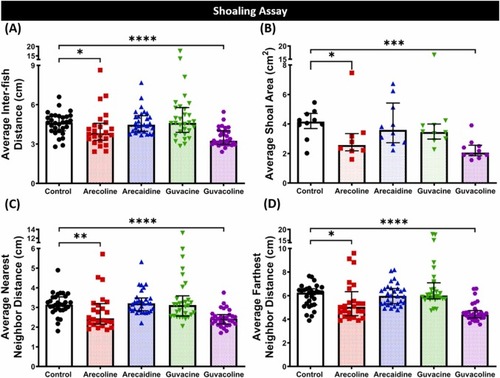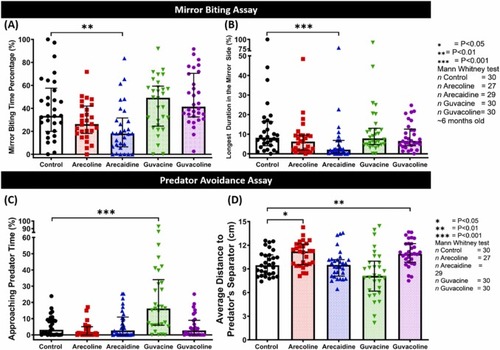- Title
-
Comparison of the psychoactive activity of four primary Areca nut alkaloids in zebrafish by behavioral approach and molecular docking
- Authors
- Siregar, P., Audira, G., Castillo, A.L., Roldan, M.J.M., Suryanto, M.E., Liu, R.X., Lin, Y.T., Lai, Y.H., Hsiao, C.D.
- Source
- Full text @ Biomed. Pharmacother.
|
Fig. 1. Overview of the current study on evaluating the potential adverse effects of areca nut alkaloid compounds in zebrafish. |
|
Fig. 2. Profile plots of behavior endpoints of untreated control, arecoline, arecaidine, guvacine, and guvacoline exposed zebrafish from novel tank test (A) before and (B) after 11 min exposure to the novel environment. The plots are expressed as the differences in the median of every treated group to the control group. (C) Summary table of behavioral differences between untreated and treated zebrafish groups. The upward arrow (↑) and downward arrow (↓) represent a statistically significant increase and decrease in the value of comparison between untreated and treated zebrafish groups, respectively. The data from all timepoints were put together and analyzed by the Two-Way ANOVA test with the Geisser-Greenhouse correction (n = 30 for the control, Arecaidine, Guvacine, and Guvacoline treatment groups; n = 27 for Arecoline treatment groups, * P < 0.05, *** P < 0.001). |
|
Fig. 3. Comparison of behavior endpoints between untreated control, arecoline, arecaidine, guvacine, and guvacoline exposed zebrafish in shoaling tests. (A) Average inter-fish distance, (B) average shoal area, (C) average nearest neighbor distance, and (D) average farthest neighbor distance were analyzed. The data are expressed as the median with interquartile range and were analyzed by Kruskal-Wallis test continued with uncorrected Dunn’s test (n = 30 for the control, arecaidine, guvacine, and guvacoline treatment groups; n = 24 for arecoline treatment groups, * P < 0.05, ** P < 0.01, *** P < 0.001, **** P < 0.0001). Each shoal consists of three fish in one tank. |
|
Fig. 4. Comparison of behavior endpoints between untreated control, arecoline, arecaidine, guvacine, and guvacoline exposed zebrafish with mirror biting and predator avoidance tests. (A) Mirror biting time percentage and (B) longest duration in the mirror side were analyzed during the mirror biting test while (C) approaching predator time and (D) average distance to predator’s separator were analyzed during the predator avoidance test. The data are expressed as the median with interquartile range and were analyzed by Kruskal-Wallis test continued with uncorrected Dunn’s test (n = 30 for the control, Guvacine, and Guvacoline treatment groups; n = 29 for Arecaidine treatment groups, n = 27 for Arecoline treatment groups, * P < 0.05, ** P < 0.01, *** P < 0.001). |
|
Fig. 5. Comparison of behavior endpoints between untreated control, arecoline, arecaidine, guvacine, and guvacoline exposed zebrafish in social interaction tests. (A) Conspecific interaction time percentage, (B) longest conspecific interaction, and (C) average distance to the conspecific’s separator. The data are expressed as the median with interquartile range and were analyzed by Kruskal-Wallis test continued with uncorrected Dunn’s test (n = 30 for the control, guvacine, and guvacoline treatment groups; n = 29 for arecaidine treatment groups, n = 27 for arecoline treatment groups, * P < 0.05, ** P < 0.01, *** P < 0.001, **** P < 0.0001). |
|
Fig. 6. Comparison of behavioral alterations in zebrafish treated with arecoline, arecaidine, guvacine, or guvacoline. (A) Principal component analysis (PCA) and (B) Hierarchical clustering and heat map analysis of behavioral alterations in adult zebrafish after exposed to four primary alkaloids from areca nuts, namely, arecoline (blue color), arecaidine (red color), guvacine (purple color) and guvacoline (orange color). In addition, a control group (green color) was also added. |






